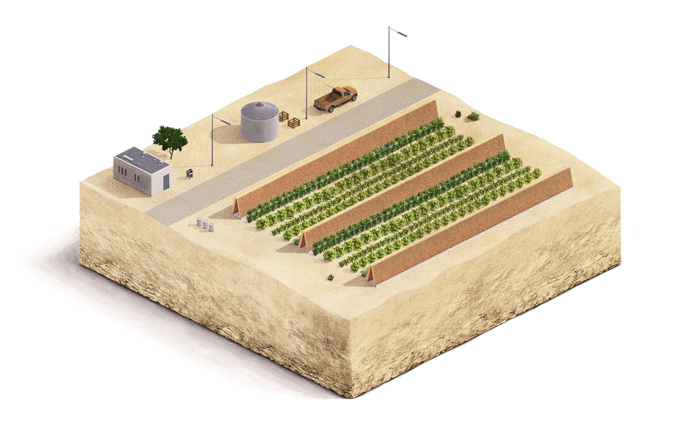The saltwater can be utilized in the greenhouses until it reaches a salt concentration of approximately 7-12%. When it becomes too concentrated to provide the careful climate control needed in the greenhouse, it still has an evaporative cooling and humidification potential. Saltwater solutions do not become saturated until they reach concentrations of about 30%. Moving from a concentration of 10% to 30% implies removing almost 75% of the remaining water still contained in the brine. Rather than letting this precious freshwater resource go to waste, it is put to further work as humidity in the SFP facility. The 10% brine will be piped from the greenhouses to an array of evaporative hedges positioned throughout the site. These hedges serve a dual purpose: they concentrate the brine by evaporating away the water content. According to the same physics that drives the evaporative systems in the greenhouses, these hedges also provide evaporative cooling and humidification to areas downwind of their position. These humidified spaces will provide a place for outdoor vegetation. The plants can take advantage of the cooler, more humid, and wind-sheltered environment provided by the hedges, making it possible to grow a broader range of crops than in open conditions.
Estimates and testing suggest that the irrigation requirement of plants grown within this area will be reduced up to 40%. Further reductions may be achieved, possibly by incorporating shading of the growing area, such as that available within the SFP facility from the CSP solar collectors.
Revegetation
By reducing thermal and water stress on plants while also providing shelter from wind, the hedges create outdoor growing spaces in which higher-value species usually unable to grow in deserts can be cultivated and where native desert plants can thrive, creating a crucial foothold from which to push back against desertification. In addition, desert plants are highly adapted, highly opportunistic species that maximally utilize limited resources. Native species are thus expected to grow rapidly and densely within the growing areas between hedges. Many will do so without any irrigation, while others may benefit from a minimal level of irrigation utilizing the freshwater produced at the SFP facility.
Additional soil-conditioning services can be provided by some compounds extracted from the remaining seawater brine, such as calcium carbonate to decrease porosity in fast-draining sands and gypsum to reduce salinity in brackish soils. Waste biomass from the greenhouses and that from the outdoor crops themselves will also be returned in a raw or processed form to the soil to increase carbon and nutrient content. These native species serve not only to restore and strengthen the natural desert ecosystem while incorporating CO2 from the atmosphere but also have commercial applications as sources of fodder, vegetable oil for nutrition and energy, and even food.
A small amount of irrigation can open up the possibilities of growing a wide range of desert-tolerant species with value as fodder, cosmetic and medicinal ingredients, bioenergy feedstock, and ornamental plants. It can also increase the productivity of high-value desert species that could survive without irrigation but can thrive with small amounts of excess water and care.
Looking beyond purely native species, some higher value fodder and food crops may also be suitable for cultivation in the humidified growing regions between hedges. These crops will all be irrigated using freshwater generated in the greenhouses and at an integrated desalination plant. Like their native counterparts, they will be cultivated in soils improved and enriched with compounds extracted from the seawater brine and with the biomass waste products of the horticultural and agricultural operations.
We envision a continuum of vegetation in and around the Sahara Forest Project facility. Hedges will characterize the most controlled agricultural areas placed close enough together to provide uniform climate conditions and operated with the least concentrated, most evaporative efficient brine to give the most effective cooling and humidification. These spaces host commercial food crops grown in heavily conditioned soil and irrigated.
The next tier of growing space will comprise only marginally less sheltered areas, still humidified and cooled by the hedges, where medicinal, fodder, and even energy crops will be cultivated with low irrigation levels. It is in these spaces that biological soil mitigation measures may prove most interesting – for example, growing nitrogen-fixing legumes interspersed with other crops to increasing nutrient availability or using halophytic (salt-tolerant) plants to extract quantities of salt from brackish soil. Finally, the outer growing spaces will be the least controlled and characterized by larger areas between hedges and fewer soil-conditioning measures. These will host un-irrigated native desert species chosen for their grazing, fodder, ecological, aesthetic, or restorative potentials. Here, the marginal environmental improvements of humidification and shelter provided by the hedges are enough to spur growth in desert species so adept at maximizing opportunity and resources. Once a robust ecosystem has been established, these revegetated desert areas could become permanent and self-sustaining. The hedges could then be redeployed elsewhere to facilitate further revegetation.
Carbon storage
By revegetating low-productivity desert areas, the Sahara Forest Project will sequester carbon from the atmosphere into its oases’ plants, roots, and soil. Such practices represent a unique possibility for removing CO2 from the atmosphere and storing it in biological material in a previously barren land – a genuinely carbon-negative solution. Such measures have the potential to be an effective tool on a global scale in limiting the effect of global warming. The sequestration rates will depend on the types of plants cultivated, the methods of cultivation, grazing, and harvesting utilized, and the specific product that is achieved in the Sahara Forest Project’s growing spaces. Trees tend to sequester significantly more CO2 than shrubs and grasses. For example, farmed eucalyptus plantations can sequester some 20–40 tons of CO2/hectare/year, while seeded revegetation of shrub-like native species tends to sequester figures only half as high. However, plants of any size with extensive root systems can sequester large quantities of carbon. Typically, sequestration rates are lower in arid environments, as plants grow less rapidly due to environmental stress.

